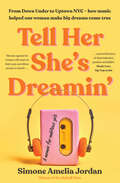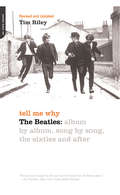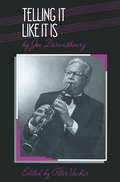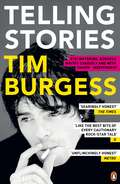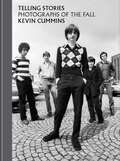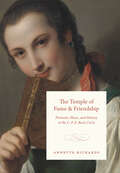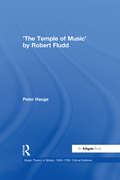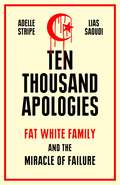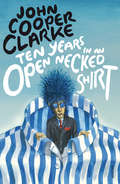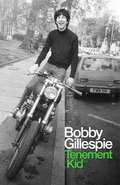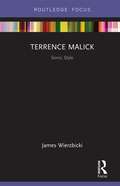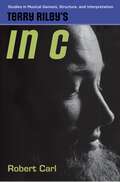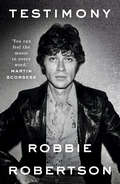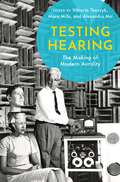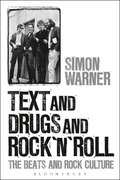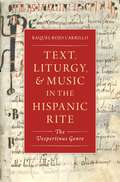- Table View
- List View
Television's Marquee Moon (33 1/3)
by Bryan WatermanA thoroughly researched study of the origins of the New York City punk scene, focusing on Television and their extraordinary debut record.
Tell Her She's Dreamin': A memoir for ambitious girls
by Simone Amelia JordanThis book is a love letter to women longing to break free of the boxes their postcode, skin colour, gender and bank balance put them in. Its title is a rebel yell to ambitious women and girls hungry for more. Growing up on the whitewashed Central Coast in the 1980s and attending an elite school as a scholarship student from the wrong side of the tracks, Lebanese-Cypriot Simone Amelia Jordan felt like an outcast among her peers for years. Her lifeline was hip-hop, then in its golden age. From girlhood, Simone recognised the art form's pro-Black consciousness, and the rappers' resonant words inspired her to embrace her own identity and back herself. From founding Australia's most successful hip-hop and R&B publication to moving to New York City and interviewing the biggest stars of the time as the editor of the world's most beloved rap magazine; falling in love and getting her heart broken; grappling with her family ties to culture; and struggling through illness and sexual grooming, Simone's inspiring story is about defying the odds to reach for your dreams. But it is also about figuring out those dreams can change as you do.Tell Her She's Dreamin' is a deeply personal story of family, culture and music that disrupts the long-held view that women, and racially diverse women especially, are limited in their power as bold, playful explorers. It is a timely manual for those hellbent on going places and an inspiration for anyone who has ever been told they can't. (Spoiler alert: you can!)
Tell Me Why: The Beatles: Album By Album, Song By Song, The Sixties And After
by Tim RileyA unique combination of musical analysis and cultural history, Tell Me Why stands alone among Beatles books with its single-minded focus on the most important aspect of the band: its music. Riley offers a new, deeper understanding of the Beatles by closely considering each song and album they recorded in an exploration as rigorous as it is soulful. He tirelessly sifts through the Beatles discography, making clear that the legendary four were more than mere teen idols: They were brilliant innovators who mastered an extremely detailed art. Since the first publication of Tell Me Why in 1988, much new primary source material has appeared -- Paul McCartney's authorized biography, the Anthology CDs and videos, the complete Parlophone-sequenced albums on CD, the Live at the BBCsessions, and the global smash 1. Riley incorporates all the new material in an update that makes this a crucial book for Beatles fans.
Tell Me Why: The Beatles: Album By Album, Song By Song, The Sixties And After
by Tim RileyA unique combination of musical analysis and cultural history, Tell Me Why stands alone among Beatles books with its single-minded focus on the most important aspect of the band: its music. Riley offers a new, deeper understanding of the Beatles by closely considering each song and album they recorded in an exploration as rigorous as it is soulful. He tirelessly sifts through the Beatles discography, making clear that the legendary four were more than mere teen idols: They were brilliant innovators who mastered an extremely detailed art. Since the first publication of Tell Me Why in 1988, much new primary source material has appeared-Paul McCartney's authorized biography, the Anthology CDs and videos, the complete Parlophone-sequenced albums on CD, the Live at the BBCsessions, and the global smash 1. Riley incorporates all the new material in an update that makes this a crucial book for Beatles fans.
Telling It Like It Is
by Joe Darensbourg Peter VacherThe autobiography of one of the foremost jazz clarinetists who is well known for his recordings with Edward 'Kid' Ory and the Louis Armstrong All Stars. Darensbourg was born in Baton Rouge, LA, in 1906 and heard many early New Orleans jazz bands as a young boy. For most of his life he lived on the West Coast and the book is a first-rate reference source for students of jazz and popular music in the urban centres of Seattle and Los Angeles.
Telling Stories
by Tim BurgessTelling Stories by Tim Burgess of The Charlatans is one of the decade's most revealing rock books'Clear, honest. An unusually frank and well-written rock memoir' The TimesThe Charlatans. Madchester. Britpop. Taking on the world. Here are the highs, the lows, the joys, the agonies, and the stories of what it's like to be in a rock band, as told by front man and survivor, Tim Burgess. 'Like the best bits of every cautionary rock star tale . . . there is armed robbery and smuggling. There's serious fraud. There are near and actual death experiences, divorce, industrial cocaine consumption and magnificent cameos from Madonna, Alan McGee, Ronnie Wood, Joe Strummer, LA drug dealer Harry The Dog, and Joaquin Phoenix. A minor classic' QFor readers who enjoyed Life by Keith Richards and Bit of a Blur by Alex James, Telling Stories is one of the finest music books of recent times. It's a story of achievement and survival, from London to LA. 'A vivid read' Independent on Sunday'The Charlatans' frontman recalls the heyday of Britpop and Madchester with endearing exuberance. He's unflinchingly honest about the bad times but also peppers his story with anecdotal nuggets about the pitfalls of rock 'n' roll excess' Metro'Burgess keeps a level head, a sharp eye and a nice turn of phrase' Independent'Written with the stylish flow of a novel - light and dark, hilarious and melancholic' Emma Forrest'For a man whose behaviour borders on the suicidal, Timothy Burgess, the people's friend, is what you call a life enthusiast. He is also mad. It's a much-abused word, mad . . . but he really is proper coo-ee clouds pan-dimensional mad mad' Syliva Patteerson, SkyTim Burgess was born in Salford but grew up in a village near Northwich, Cheshire. Leaving school at 16 to work at ICI, his real love was music and soon afterwards he was invited to join new band The Charlatans. For twelve years Burgess lived in Los Angeles but he has recently returned to the UK.
Telling Stories: Photographs of The Fall
by Kevin Cummins***'No one has captured the look of alternative UK music over the past half a century more tellingly than Kevin Cummins.' - Simon Armitage'Kevin Cummins is a true master in being able to capture the essence of music, the soul of the band. Whatever he does however he does it is a mystery to me but it's pure genius.' - Rankin'Kevin has the uncanny ability of capturing the inner mood of musicians. Be it the dynamics within a pensive Joy Division, or the sense surrounding the fledgeling Fall that something special was around the corner for us all. Kevin's book is nothing less than a remarkable document of a bewildering and defiant anti-fashion movement born in Prestwich, north Manchester in the grimy mid-70s.' - Marc Riley'Capturing forty years of the band's career via his archive, the legendary photographer (whose recent book, Juvenes, documented the story of Joy Division) gives his take on the phenomenon of The Fall and the late, great Mark E. Smith.' - Vive le Rock Contains never-before-seen images.Foreword by Simon Armitage, Poet Laureate. From chaotic early gigs to their final years, NME photographer Kevin Cummins provides a definitive, unique perspective on cult favourites The Fall. In this stunning visual history spanning four decades, discover how and why they emerged as one of the most innovative, boundary-breaking bands in modern music.With a foreword by Poet Laureate and Fall fan Simon Armitage and an interview with Eleni Poulou, as well as never-before-seen images from Cummins' archive, this is the ultimate visual companion to The Fall.
The Temple of Fame and Friendship: Portraits, Music, and History in the C. P. E. Bach Circle
by Annette RichardsThis book examines the renowned portrait collection assembled by C. P. E. Bach, J. S. Bach’s second son. One of the most celebrated German composers of the eighteenth century, C. P. E. Bach spent decades assembling an extensive portrait collection of some four hundred music-related items—from oil paintings to engraved prints. The collection was dispersed after Bach’s death in 1788, but with Annette Richards’s painstaking reconstruction, the portraits once again present a vivid panorama of music history and culture, reanimating the sensibility and humor of Bach’s time. Far more than a mere multitude of faces, Richards argues, the collection was a major part of the composer’s work that sought to establish music as an object of aesthetic, philosophical, and historical study. The Temple of Fame and Friendship brings C. P. E. Bach’s collection to life, giving readers a sense of what it was like for visitors to tour the portrait gallery and experience music in rooms thick with the faces of friends, colleagues, and forebears. She uses the collection to analyze the “portraitive” aspect of Bach’s music, engaging with the influential theories of Swiss physiognomist Johann Caspar Lavater. She also explores the collection as a mode of cultivating and preserving friendship, connecting this to the culture of remembrance that resonates in Bach’s domestic music. Richards shows how the new music historiography of the late eighteenth century, rich in anecdote, memoir, and verbal portrait, was deeply indebted to portrait collecting and its negotiation between presence and detachment, fact and feeling.
'The Temple of Music' by Robert Fludd (Music Theory in Britain, 1500–1700: Critical Editions)
by Peter HaugeRobert Fludd (1574-1637) is well known among historians of science and philosophy for his intriguing work, The Metaphysical, Physical and Technical History of both Major and Minor Worlds, in which music plays an important role in his system of neoplatonic correspondences: the harmony of the universe (macrocosm) as well as the harmony of man (microcosm). 'The Temple of Music' (1617-18) is one section of this work, and deals with music theory, practice and organology. Many musicologists today have dismissed his musical ideas as conservative and outmoded or mainly based on fantasy; only the chapters on instruments have received some attention. However, reading Fludd's work on music theory and practice in the context of his own time and comparing it with other contemporary treatises, it is apparent that much of it contains highly original ideas and cannot be considered old fashioned or conservative. It is evident that Fludd's music philosophy influenced and provoked contemporary natural philosophers such as Marin Mersenne and Johannes Kepler. Less well known is the fact that Fludd's music theory reveals aspects of the development of new concepts that appear to reflect contemporary writers on music such as John Coprario and Thomas Campion. Before now, 'The Temple of Music' has not been easily accessible or available, and the fact that Fludd wrote in Latin has also been prohibitive. This critical edition provides the original Latin, an English translation and essential illustrations. The book will therefore be a useful tool for understanding the position of English music theory around 1600.
'The Temple of Music' by Robert Fludd (Music Theory in Britain, 1500–1700: Critical Editions)
by Peter HaugeRobert Fludd (1574-1637) is well known among historians of science and philosophy for his intriguing work, The Metaphysical, Physical and Technical History of both Major and Minor Worlds, in which music plays an important role in his system of neoplatonic correspondences: the harmony of the universe (macrocosm) as well as the harmony of man (microcosm). 'The Temple of Music' (1617-18) is one section of this work, and deals with music theory, practice and organology. Many musicologists today have dismissed his musical ideas as conservative and outmoded or mainly based on fantasy; only the chapters on instruments have received some attention. However, reading Fludd's work on music theory and practice in the context of his own time and comparing it with other contemporary treatises, it is apparent that much of it contains highly original ideas and cannot be considered old fashioned or conservative. It is evident that Fludd's music philosophy influenced and provoked contemporary natural philosophers such as Marin Mersenne and Johannes Kepler. Less well known is the fact that Fludd's music theory reveals aspects of the development of new concepts that appear to reflect contemporary writers on music such as John Coprario and Thomas Campion. Before now, 'The Temple of Music' has not been easily accessible or available, and the fact that Fludd wrote in Latin has also been prohibitive. This critical edition provides the original Latin, an English translation and essential illustrations. The book will therefore be a useful tool for understanding the position of English music theory around 1600.
Ten Thousand Apologies: Fat White Family and the Miracle of Failure
by Adelle Stripe Lias SaoudiFrom the mountains of Algeria to the squats of South London via sectarian Northern Ireland, Ten Thousand Apologies is the sordid and thrilling story of the country's most notorious cult band, Fat White Family. Loved and loathed in equal measure since their formation in 2011, the relentlessly provocative, stunningly dysfunctional "drug band with a rock problem" have dedicated themselves to constant chaos and total creative freedom at all costs.Like a tragicomic penny dreadful dreamed up by a mutant hybrid of Jean Genet, the Dadaists and Mark E. Smith, the Fat Whites' story is a frequently jaw-dropping epic of creative insurrection, narcotic excess, mental illness, wanderlust, self-sabotage, fractured masculinity, and the ruthless pursuit of absolute art.Co-written with lucidity and humour by singer Lias Saoudi and acclaimed author Adelle Stripe, Ten Thousand Apologies is that rare thing: a music book that barely features any music, a biography as literary as any novel, and a confessional that does not seek forgiveness. This is the definitive account of Fat White Family's disgraceful and radiant jihad - a depraved, romantic and furious gesture of refusal to a sanitised era.
Ten Years in an Open Necked Shirt
by John Cooper Clarke‘Yes, it was be there or be square as, clad in the slum chic of the hipster, he issued the slang anthems of the zip age in the desperate esperanto of the bop. John Cooper Clarke: the name behind the hairstyle, the words walk in the grooves hacking through the hi-fi paradise of true luxury’Punk. Poet. Pioneer. The Bard of Salford’s seminal collection is as scabrous, wry & vivid now as it was when first published over 25 years ago. ‘The godfather of British performance poetry’Daily Telegraph
Tenement Kid: Rough Trade Book of the Year
by Bobby GillespieTenement Kid is Bobby Gillespie's story up to the recording and release of the album that has been credited with 'starting the 90's', Screamadelica.Born into a working class Glaswegian family in the summer of 1961, Bobby's memoirs begin in the district of Springburn, soon to be evacuated in Edward Heath's brutal slum clearances. Leaving school at 16 and going to work as a printers' apprentice, Bobby's rock n roll epiphany arrives like a bolt of lightning shining from Phil Lynott's mirrored pickguard at his first gig at the Apollo in Glasgow. Filled with 'the holy spirit of rock n roll' his destiny is sealed with the arrival of the Sex Pistols and punk rock which to Bobby, represents an iconoclastic vision of class rebellion and would ultimately lead to him becoming an artist initially in the Jesus and Mary Chain then in Primal Scream.Structured in four parts, Tenement Kid builds like a breakbeat crescendo to the final quarter of the book, the Summer of Love, Boys Own parties, and the fateful meeting with Andrew Weatherall in an East Sussex field. As the '80s bleed into the '90s and a new kind of electronic soul music starts to pulse through the nation's consciousness, Primal Scream become the most innovative British band of the new decade, representing a new psychedelic vanguard taking shape at Creation Records.Ending with the release of Screamadelica and the tour that followed in the autumn, Tenement Kid is a book filled with the joy and wonder of a rock n roll apostle who would radically reshape the future sounds of fin de siècle British pop. Published thirty years after the release of their masterpiece, Bobby Gillespie's memoir cuts a righteous path through a decade lost to Thatcherism and saved by acid house.
Terrence Malick: Sonic Style (Filmmakers and Their Soundtracks)
by James WierzbickiIn the course of a decades-spanning career as a filmmaker, Terrence Malick has carved out a distinctive cinematic aesthetic. Central to this style is the use of sound. James Wierzbicki offers the first comprehensive study of Malick's soundtracks, arguing that they create a distinctive sonic style throughout his oeuvre and exploring how that style functions. Considering voice, noise, and music as elements in the soundtrack, this concise book enriches our understanding of one of our most philosophical filmmakers, and of the interplay between the sonic and visual elements in film.
Terrence Malick: Sonic Style (Filmmakers and Their Soundtracks)
by James WierzbickiIn the course of a decades-spanning career as a filmmaker, Terrence Malick has carved out a distinctive cinematic aesthetic. Central to this style is the use of sound. James Wierzbicki offers the first comprehensive study of Malick's soundtracks, arguing that they create a distinctive sonic style throughout his oeuvre and exploring how that style functions. Considering voice, noise, and music as elements in the soundtrack, this concise book enriches our understanding of one of our most philosophical filmmakers, and of the interplay between the sonic and visual elements in film.
Terry Riley's In C (Studies in Musical Genesis, Structure, and Interpretation)
by Robert CarlSetting the stage for a most intriguing journey into the world of minimalism, Robert Carl's Terry Riley's In C argues that the work holds its place in the canon because of the very challenges it presents to "classical" music. Carl examines In C in the context of its era, its grounding in aesthetic practices and assumptions, its process of composition, presentation, recording, and dissemination.
Terry Riley's In C (Studies in Musical Genesis, Structure, and Interpretation)
by Robert CarlSetting the stage for a most intriguing journey into the world of minimalism, Robert Carl's Terry Riley's In C argues that the work holds its place in the canon because of the very challenges it presents to "classical" music. Carl examines In C in the context of its era, its grounding in aesthetic practices and assumptions, its process of composition, presentation, recording, and dissemination.
Testimony
by Robbie RobertsonRobbie Robertson's singular contributions to popular music have made him one of the most beloved songwriters and guitarists of his time. With songs like ‘The Weight’, ‘The Night They Drove Old Dixie Down’ and ‘Up on Cripple Creek’, he and his partners in the Band fashioned a music that has endured for decades, influencing countless musicians.In this captivating memoir, written over five years of reflection, Robbie employs his unique storyteller's voice to weave together the journey that led him to some of the most pivotal events in music history. He recounts the adventures of his half-Jewish, half-Mohawk upbringing on the Six Nations Indian Reserve and on the gritty streets of Toronto; his odyssey at sixteen to the Mississippi Delta, the fountainhead of American music; the wild, early years on the road with rockabilly legend Ronnie Hawkins and the Hawks; his unexpected ties to the Cosa Nostra underworld; the gripping trial-by-fire of 'going electric' with Bob Dylan on his 1966 world tour and their ensuing celebrated collaborations; the formation of the Band and the forging of their unique sound, culminating with history’s most famous farewell concert, brought to life for all time in Martin Scorsese’s great movie The Last Waltz. This is the story of a time and place - the moment when rock 'n' roll became life, when legends like Buddy Holly and Bo Diddley crisscrossed the circuit of clubs and roadhouses from Texas to Toronto, when the Beatles, Hendrix, the Stones and Warhol moved through the same streets and hotel rooms. It’s the story of exciting change as the world tumbled through the '60s and early '70s and a generation came of age, built on music, love and freedom. Above all, it’s the moving story of the profound friendship among five young men who together created a new kind of popular music. Testimony is Robbie Robertson’s story, lyrical and true, as only he could tell it.
Testing Hearing: The Making of Modern Aurality
by Viktoria Tkaczyk, Mara Mills, and Alexandra HuiTesting Hearing: The Making of Modern Aurality argues that the modern cultural practices of hearing and testing have emerged from a long interrelationship. Since the early nineteenth century, auditory test tools (whether organ pipes or electronic tone generators) and the results of hearing tests have fed back into instrument calibration, human training, architecture, and the creation of new musical sounds. Hearing tests received a further boost around 1900 as a result of injury compensation laws and state and professional demands for aptitude testing in schools, conservatories, the military, and other fields. Applied at large scale, tests of seemingly small measure-of auditory acuity, of hearing range-helped redefine the modern concept of hearing as such. During the twentieth and twenty-first centuries, the epistemic function of hearing expanded. Hearing took on the dual role of test object and test instrument; in the latter case, human hearing became a gauge by which to evaluate or regulate materials, nonhuman organisms, equipment, and technological systems. This book considers both the testing of hearing and testing with hearing to explore the co-creation of modern epistemic and auditory cultures. The book's twelve contributors trace the design of ever more specific tests for the arts, education and communication, colonial and military applications, sociopolitical and industrial endeavors. Together, they demonstrate that testing as such became an enduring and wide-ranging cultural technique in the modern period, one that is situated between histories of scientific experimentation and many fields of application.
Testing Hearing: The Making of Modern Aurality
Testing Hearing: The Making of Modern Aurality argues that the modern cultural practices of hearing and testing have emerged from a long interrelationship. Since the early nineteenth century, auditory test tools (whether organ pipes or electronic tone generators) and the results of hearing tests have fed back into instrument calibration, human training, architecture, and the creation of new musical sounds. Hearing tests received a further boost around 1900 as a result of injury compensation laws and state and professional demands for aptitude testing in schools, conservatories, the military, and other fields. Applied at large scale, tests of seemingly small measure-of auditory acuity, of hearing range-helped redefine the modern concept of hearing as such. During the twentieth and twenty-first centuries, the epistemic function of hearing expanded. Hearing took on the dual role of test object and test instrument; in the latter case, human hearing became a gauge by which to evaluate or regulate materials, nonhuman organisms, equipment, and technological systems. This book considers both the testing of hearing and testing with hearing to explore the co-creation of modern epistemic and auditory cultures. The book's twelve contributors trace the design of ever more specific tests for the arts, education and communication, colonial and military applications, sociopolitical and industrial endeavors. Together, they demonstrate that testing as such became an enduring and wide-ranging cultural technique in the modern period, one that is situated between histories of scientific experimentation and many fields of application.
Text and Drugs and Rock 'n' Roll: The Beats and Rock Culture
by Simon WarnerText and Drugs and Rock'n'Roll explores the interaction between two of the most powerful socio-cultural movements in the post-war years - the literary forces of the Beat Generation and the musical energies of rock and its attendant culture.Simon Warner examines the interweaving strands, seeded by the poet/novelists Jack Kerouac, Allen Ginsberg, William Burroughs and others in the 1940s and 1950s, and cultivated by most of the major rock figures who emerged after 1960 - Bob Dylan, the Beatles, Bowie, the Clash and Kurt Cobain, to name just a few.This fascinating cultural history delves into a wide range of issues: Was rock culture the natural heir to the activities of the Beats? Were the hippies the Beats of the 1960s? What attitude did the Beat writers have towards musical forms and particularly rock music? How did literary works shape the consciousness of leading rock music-makers and their followers? Why did Beat literature retain its cultural potency with later rock musicians who rejected hippie values? How did rock musicians use the material of Beat literature in their own work? How did Beat figures become embroiled in the process of rock creativity? These questions are addressed through a number of approaches - the influence of drugs, the relevance of politics, the effect of religious and spiritual pursuits, the rise of the counter-culture, the issue of sub-cultures and their construction, and so on. The result is a highly readable history of the innumerable links between two of the most revolutionary artistic movements of the last 60 years.
Text and Drugs and Rock 'n' Roll: The Beats and Rock Culture
by Simon WarnerText and Drugs and Rock'n'Roll explores the interaction between two of the most powerful socio-cultural movements in the post-war years - the literary forces of the Beat Generation and the musical energies of rock and its attendant culture.Simon Warner examines the interweaving strands, seeded by the poet/novelists Jack Kerouac, Allen Ginsberg, William Burroughs and others in the 1940s and 1950s, and cultivated by most of the major rock figures who emerged after 1960 - Bob Dylan, the Beatles, Bowie, the Clash and Kurt Cobain, to name just a few.This fascinating cultural history delves into a wide range of issues: Was rock culture the natural heir to the activities of the Beats? Were the hippies the Beats of the 1960s? What attitude did the Beat writers have towards musical forms and particularly rock music? How did literary works shape the consciousness of leading rock music-makers and their followers? Why did Beat literature retain its cultural potency with later rock musicians who rejected hippie values? How did rock musicians use the material of Beat literature in their own work? How did Beat figures become embroiled in the process of rock creativity? These questions are addressed through a number of approaches - the influence of drugs, the relevance of politics, the effect of religious and spiritual pursuits, the rise of the counter-culture, the issue of sub-cultures and their construction, and so on. The result is a highly readable history of the innumerable links between two of the most revolutionary artistic movements of the last 60 years.
Text, Liturgy, and Music in the Hispanic Rite: The Vespertinus Genre (Currents in Latin American and Iberian Music)
by Raquel Rojo CarrilloThe Hispanic rite, a medieval non-Roman Western liturgy, was practiced across the Iberian Peninsula for over half a millennium and functioned as the most distinct marker of Christian identity in this region. As Christians typically began every liturgical day throughout the year by singing a vespertinus, this chant genre in particular provides a unique window into the cultural and religious life of medieval Iberia. The Hispanic rite has the largest corpus of extant manuscripts of all non-Roman liturgies in the West, which testifies to the importance placed on their transmission through political and cultural upheavals. Its chants, however, use a notational system that lacks clear specification of pitch and has kept them barred from in-depth study. Text, Liturgy and Music in the Hispanic Rite is the first detailed analysis of the interactions between textual, liturgical, and musical variables across the entire extant repertoire of a chant genre central to the Hispanic rite, the vespertinus. By approaching the vespertini through a holistic methodology that integrates liturgy, melody, and text, author Raquel Rojo Carrillo identifies the genre's norms and traces the different shapes it adopts across the liturgical year and on different occasions. In this way, the book offers an unprecedented insight into the liturgical edifice of the Hispanic rite and the daily experience of Christians in medieval Iberia.
Text, Liturgy, and Music in the Hispanic Rite: The Vespertinus Genre (Currents in Latin American and Iberian Music)
by Raquel Rojo CarrilloThe Hispanic rite, a medieval non-Roman Western liturgy, was practiced across the Iberian Peninsula for over half a millennium and functioned as the most distinct marker of Christian identity in this region. As Christians typically began every liturgical day throughout the year by singing a vespertinus, this chant genre in particular provides a unique window into the cultural and religious life of medieval Iberia. The Hispanic rite has the largest corpus of extant manuscripts of all non-Roman liturgies in the West, which testifies to the importance placed on their transmission through political and cultural upheavals. Its chants, however, use a notational system that lacks clear specification of pitch and has kept them barred from in-depth study. Text, Liturgy and Music in the Hispanic Rite is the first detailed analysis of the interactions between textual, liturgical, and musical variables across the entire extant repertoire of a chant genre central to the Hispanic rite, the vespertinus. By approaching the vespertini through a holistic methodology that integrates liturgy, melody, and text, author Raquel Rojo Carrillo identifies the genre's norms and traces the different shapes it adopts across the liturgical year and on different occasions. In this way, the book offers an unprecedented insight into the liturgical edifice of the Hispanic rite and the daily experience of Christians in medieval Iberia.

